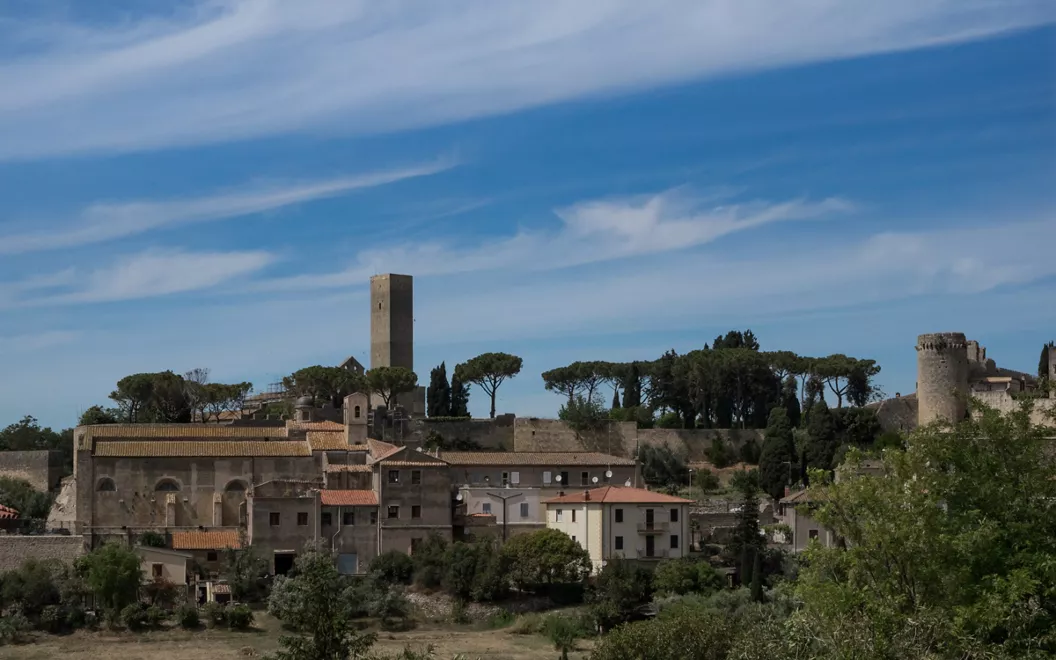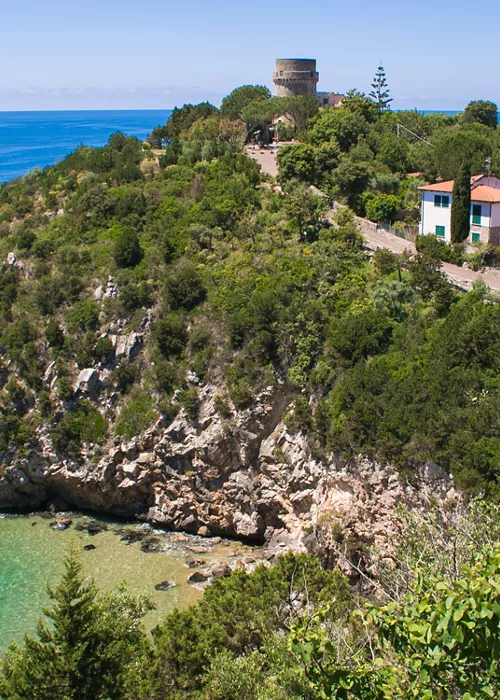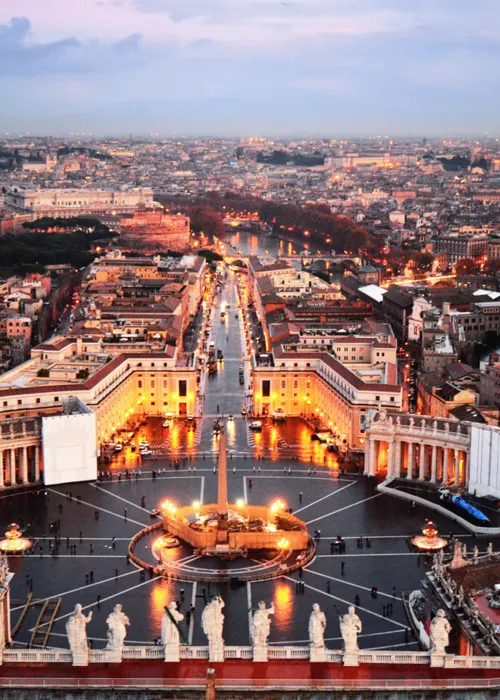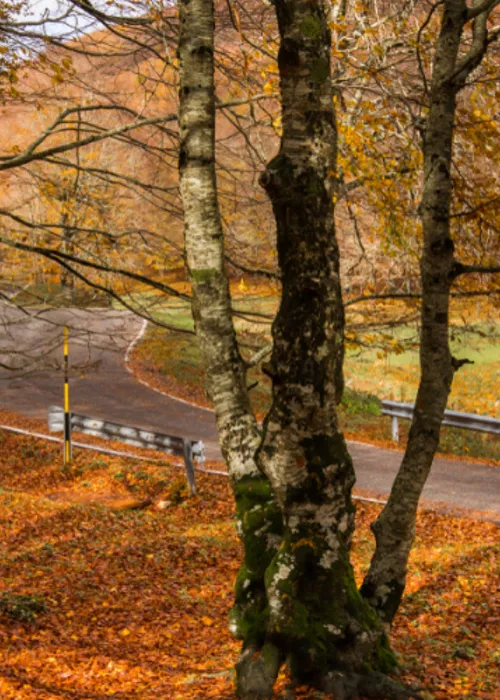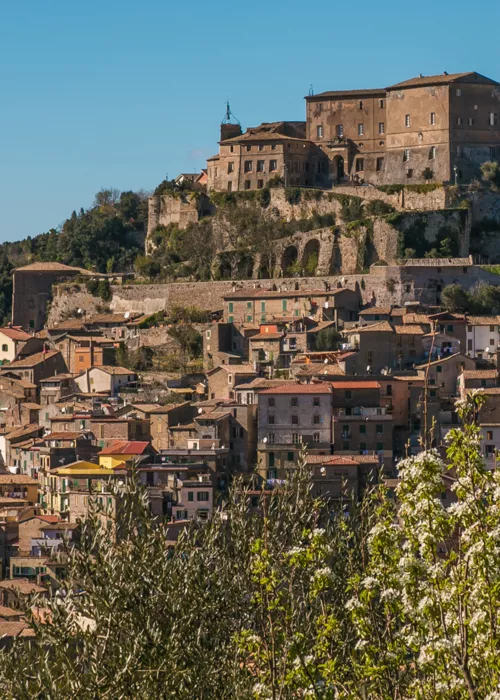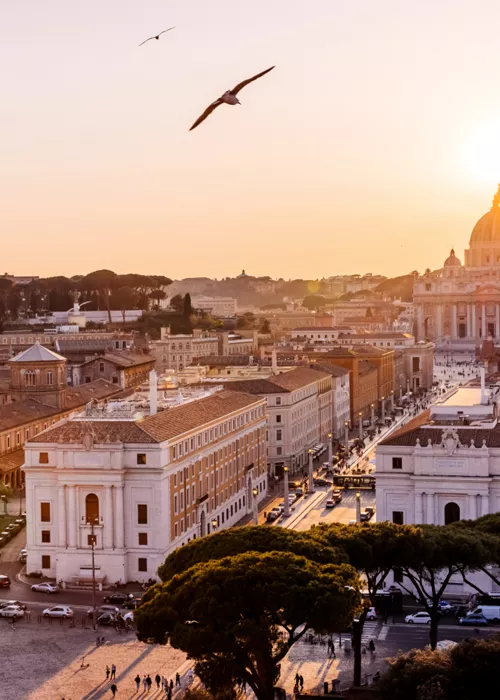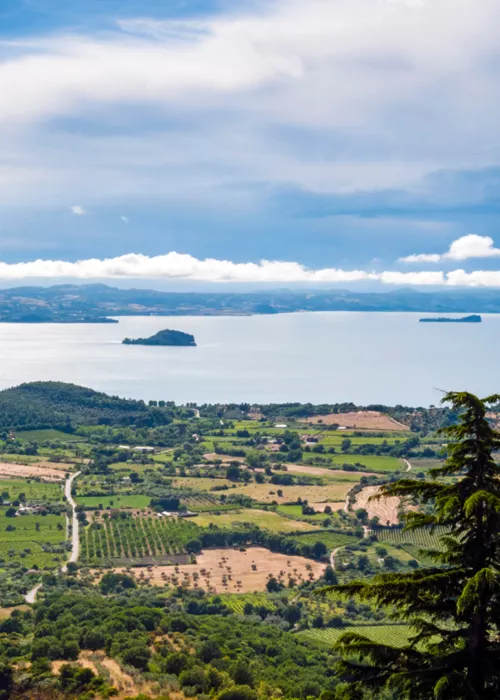Tuscania

Dominated by the gentle lines of the Monti Volsini and crossed by via Clodia, which connects it to Rome, the area of Tuscania has been inhabited without interruption for almost three millennia. It was already a centre of strategic importance at the time of the Etruscan civilisation, and continued to be so in Roman and medieval times: not even the serious earthquake of 1971 managed to interrupt the vitality of this ancient settlement. A historical city of art and culture, today's Tuscania has also carved out an important role for itself in wood, terracotta and leather working.
Scattered with towers, churches and evocative squares, and surrounded by a beautiful city wall, the historical centre of Tuscania preserves a number of archaeological finds along its streets, recovered during 19th-century excavations and placed in the streets as decorative elements. Here you can stroll among the fountains and churches of Piazza Basile and Piazza Bastianini, before plunging headlong into Etruscan history at the National Archaeological Museum of Tuscania.
Slightly displaced from the medieval walls, two majestic Romanesque churches stand out among the most significant places of worship in the entire region. Moving eastwards from the historical centre, one first encounters the striking façade of the church of S. Maria Maggiore, populated by an astonishing array of decorative elements; walking a little further on, the view opens up to the St. Peter's Basilica, whose architectural lines form a complex puzzle of influences and styles.
A visit to Tuscania will not fail to delve into the smells and flavours of the typical food and wine: among the fresh pastas we remember the very original lombrichelli while, after a second course based on local game, it will be time to have some of the locals tell you the secret recipe for diomenguardi, a special sweet with an authentic Maremma soul.
Before leaving, the Etruscan necropolis distributed around Tuscania, such as that of the Madonna dell 'olivo - Grotta della Regina, where many of the artefacts now on display in the National Archaeological Museum in Tuscania were found.
Farnese

Along the road from Tuscania to Farnese, you will encounter hills of volcanic origin that become progressively more majestic as you approach the Volsini mountains. Without ever touching them, the route skirts the shores of Lake Bolsena, a destination for seaside tourism thanks to its sandy beaches and land of DOC wines, such as the Est! Est!! Est!!! of Montefiascone and the Aleatico di Gradoli.
After passing the municipality of Ischia di Castro, you can reach Farnese after a few minutes, which quickly reveals its characteristics as an archetypal village of Tuscia. Here, in fact, you will find everything you would expect from a medieval settlement on the border between Tuscany and Lazio: the steep, circular structure, perched on a crag of tufa; a series of charming churches and palaces; the friendliness of the inhabitants, heirs to ancient traditions that brought the name Farnese to the lips of half of Europe.
Yes, because the origin of this village are the members of the Farnese dynasty, who took their name from here. A family that, especially between the 16th and 18th centuries, represented one of the most powerful lineages of the European aristocracy.
Despite their political and ecclesiastical commitments, the Farnese commanders, dukes and popes never forgot their home territory. The streets and squares of the village are dotted with works commissioned during centuries of domination in Tuscia, to be discovered especially by visiting the churches of Santa Maria della Neve and Santissimo Salvatore.
Vulci Archaeological Nature Park

The historical influence of the Farnese family continues to be felt in the bucolic places along the road between the Volsini mountains and the sea. In 1468, Alessandro Farnese was born in Canino, known for its medieval centre and for a fine Maremma olive oil. Assuming the name of Paul III after his election as pontiff in 1534, this pope went down in history above all for having ratified the creation of the Jesuit order of Ignatius of Loyola.
Between the municipalities of Canino and Montalto di Castro, we reach Vulci, a town closely linked to Etruscan and then Roman events. A powerful city a short distance from the sea, Vulci was part of the Etruscan dodecapolis, a network of twelve city-states capable of forging an economic, religious and military alliance between them. Unlike Tuscania, which continued to flourish even after the Roman conquest, Vulci suffered greatly from the new domination, which sanctioned its irreparable decline.
An archaeological nature park extends around the ancient settlement of Vulci. While the remains of ancient necropolises and domus provide the main focus of the visit, there are also plenty of picturesque excursion trails in Vulci, which can be covered on foot, on horseback or by bicycle. The protected and valued environment here creates a perfect postcard of the green Maremma plain, especially along the banks of the Fiora river, which, descending from Mount Amiata, flows through Vulci before reaching the sea at Montalto Marina.
Most of the archaeological finds from the excavations on the site are now exhibited in the Vulci National Archaeological Museum, housed in the Abbey castle. Once again, the Farnese family were the protagonists of events in Maremma Laziale: apparently Cardinal Alessandro Farnese (before becoming Pope Paul III) was responsible for the current appearance of the Abbadia fortress, strategically positioned beside a bridge over a rocky gorge carved by the Fiora river.
Montalto di Castro

The descent to the Tyrrhenian Sea is almost complete when, following the course of the Fiora river to the south, you enter the town of Montalto di Castro. Although its Latin name (castrum montis alti) literally means "fortress of the high mountain", the landscape around Montalto di Castro is actually more typical of the coastlands and Maremma, composed of large, flat cultivated fields reclaimed from former marshland.
Once again, we see the constant presence of the Farnese family in the past events of Maremma Laziale: Montalto di Castro was entrusted as a fief to Pier Luigi Farnese (illegitimate son of Pope Paul III) in 1535, before becoming part of the Papal State in 1649.
Some sections of its ancient walls still surround the historic centre of Montalto di Castro, where among the alleyways and charming small squares you can experience an authentically medieval atmosphere, especially when you come to the large, majestic Guglielmi castle, a symbol of the city, whose crenellated towers are covered in bright green ivy.
Where the Fiora river flows into the sea, along a low, sandy coastline that seems to stretch to infinity, a seaside resort has been developed: Montalto Marina, a district of Montalto di Castro. The environmentally best preserved stretches of coastline, ideal for exploring in all seasons, include Murelle beach and Spinicci beach, slightly to the south of the town of Montalto Marina. Soft dunes of dark grey sand, a colour caused by the presence of iron in the minerals, form the backdrop to the landscape, a brilliant prelude to a moment of sea and fresh air. For those who want to explore it with a mask and a snorkel, the seabed reveals vast meadows of posidonia, an aquatic plant typical of the Mediterranean.
Tarquinia

From Montalto di Castro, heading south-east on the Via Aurelia, you reach Tarquinia, perched on a gentle relief, from which there are splendid views of the surrounding vineyards and fields, where artichokes, watermelons, peppers, asparagus and other products are plentiful. Just seven kilometres from the historic centre of Tarquinia, the river Marta, the only outlet from Lake Bolsena, flows into the Tyrrhenian coast.
Like Vulci, Tarquinia was also part of the dodecapolis, an ancient alliance between twelve Etruscan cities. However, more than any other settlement in Maremma Laziale, the history of Tarquinia is linked to the development of Roman power. The last three of the legendary seven kings of Rome (Tarquinius Priscus, Servius Tullius and Tarquinius II Superbus), who reigned between the 7th and 6th centuries BC, came from these places.
Significant evidence of Etruscan civilisation has survived to the present day, and can be seen in the Monterozzi necropolis, among the fields beside the historical centre of Tarquinia. Inside the tombs carved into the rock of this archaeological area, recognised asUNESCO world heritage since 2004, together with the nearby necropolis of Cerveteri, dozens of richly painted tombs can be seen that reveal the uses and customs of the Etruscan people.
You must go to the medieval and renaissance core of Tarquinia to see the hundreds of artefacts recovered from the excavations in the Monterozzi necropolis. The rooms at the Tarquinia National Archaeological Museum, housed in the prestigious Palazzo Vitelleschi, contain numerous sarcophagi, ceramics, amphorae and other everyday objects. The museum's greatest masterpiece, a symbol of the entire city, is a large terracotta relief depicting two winged horses, a sculpture of great dynamism that guarded the access to the important city temple of the Queen's Altar.
Drawing momentarily closer to our own times, between the ancient walls and the steep medieval alleyways, a walk in the centre of Tarquinia must include a visit to Piazza Matteotti, the Cathedral and the churches of San Francesco and Santa Maria in Castello, considered the most important Romanesque monument in the city
Lido di Tarquinia

A trip to Tarquinia includes a tour of its coastal area. Near the Lido di Tarquinia, stretches of sea of surprising naturalistic and archaeological value can be found, as is often the case in Maremma Laziale.
You can start exploring this section of coastline at the ruins on the Porto Clementino shore: the site in Etruscan and Roman times of the busy trading port of Gravisca, it was restored at the wishes of Pope Clement XII in 1738.
A little further south, the area around the now disused Tarquinia salt flats is home to various species of water birds, such as mallards, night herons, tits and flamingos, to name but a few. The beach closest to the salt flats is San Giorgio, which is free and without facilities. Beyond the mouth of the river Mignone, the uncontaminated landscape of Bagni di San Agostino beach can be seen, set among sand dunes particularly rich in shrubs typical of Mediterranean scrub.


